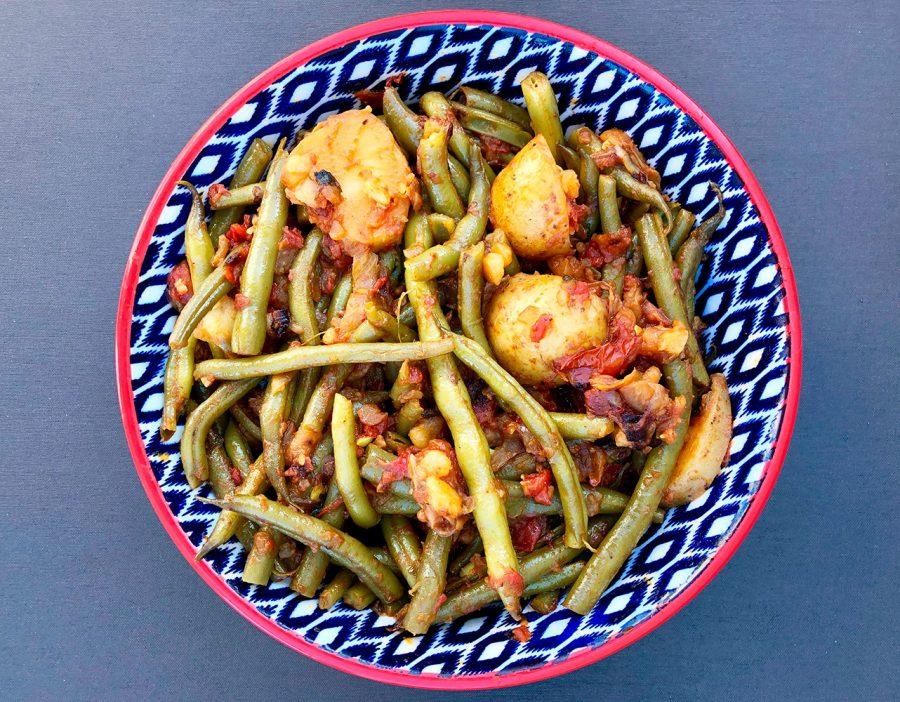Jews of Greece inspire Rosh Hashanah recipes
Published September 19, 2019
I have always enjoyed Greek food, the distinctive flavors of fresh parsley, dill, garlic, oregano, cinnamon, allspice and honey, and the use of fresh lemon in so many dishes. And, of course, the luscious vegetables that thrive in Mediterranean climates: olives, tomatoes, potatoes and beans. It all made me wonder, as I began to think of my Rosh Hashanah menu, whether I might be able to incorporate some Greek dishes into our holiday meals this year.
I assumed that the culinary traditions of Greek Jews would reflect not only their Sephardic heritage but also incorporate aspects of classic Greek cuisine. However, in researching this topic I learned about another group of Greek Jews, whose who have lived in Greece since the time of Alexander the Great about 350 B.C.E.
Known as Romaniote Jews, they established their communities in Athens, Corinth and, primarily, in Ioannina, where before World War II close to 4,000 Romaniotes resided. Romaniote Jews were in Greece long before Jews from Spain and Portugal fled there after their expulsion in 1492.
And I was surprised to learn that the city of Ioannina, with a Romaniote population of just 50, recently elected the country’s first Jewish mayor.
The Romaniote Jews spoke Yevanic, a Greek dialect written using the Hebrew alphabet. Their culinary traditions certainly echo traditional Greek cuisine, but while Greek food often pairs meats with cheeses in a single dish and includes shellfish and pork, Romaniote cuisine adheres to the laws of kashrut.
To my delight, I discovered a Romaniote community that lives in New York City. I contacted their shul, Kehila Kedosha Janina Synagogue and Musem, located on Broome Street on the Lower East Side. I spoke with Marcia Haddad Ikonomopoulos, director of the museum, which is housed in the synagogue.
“Romaniote Jews began immigrating to this country in 1906,” Ikonomopoulos said. “Our community here in New York was officially registered in1914, and the synagogue was built in 1927.”
Ikonomopoulos explained that the present community in New York City also includes traditional Sephardic Jews from Greece who, as their synagogues began closing on the Lower East Side, felt more at home in a Romaniote synagogue than in Ashkenazi congregations.
I was thrilled to see on their website that the synagogue offers cooking classes.
“Both community members and nonmembers attend our classes,” she said. “There are some classes that are given only to young Greek Jewish professionals, and others that have an audience varying in age.”
The synagogue will usually have a kiddush after services. Sometimes the food is prepared locally by a caterer, and other times,] by members of the congregation. Traditional items for the kiddush might include huevos haminados (oven cooked eggs that are brown in color); bourekas (filo dough stuffed with spinach and feta cheese or other vegetable fillings); and baklava, the classic Greek pastry made from filo dough, honey and nuts.
Ikonomopoulos also told me about some of her community’s traditional Jewish holiday foods, explaining that their Passover food traditions are more similar to Sephardic than Ashkenazic customs. Both rice and beans may be eaten on Passover, which are forbidden by Ashkenazim. Romaniote Jews usually serve roast leg of lamb bathed in a garlic broth for the main course. And unlike Ashkenazi Jews, who make charosset with apples, walnuts and sweet wine, the Romaniote Jews use only dates, walnuts and almonds.
Fresh fruit and vegetables are popular foods on Sukkot, along with fasolakia, a lovely stew of tomatoes and green beans. On Tu B’Shevat, a Romaniote menu will include grapes, figs, dates, oranges, olives, honey and, of course, pomegranate seeds.
“On Purim, we eat a sweet bread with a hard-boiled egg called tamatia of Haman (the eyes of Haman), and fried loukamades, Greek donuts with honey and walnuts,” Ikonomopoulos said. “Hamantaschen are not part of our tradition.”
And on Rosh Hashanah?
“We eat whole fish,” Ikonomopoulos said. “The father gets the head.”
Other Romaniote dishes include yemista (stuffed vegetables such as tomatoes, peppers and zucchini); keftikos de pavo (chicken and beef croquettes); prasa (leek stew); and fasolakia, the stew also served on Sukkot.
I asked Ikonomopoulos if she could send me recipes for some traditional Rosh Hashanah foods served at a Romaniote holiday meal. I’ve included below two of those recipes, both vegetarian: fasolakia, the delicious stew of fresh tomatoes, onions, green beans and potatoes; and prasa, a stew of leeks, onions, olive oil, tomatoes and fresh dill.
They would make wonderful additions to your holiday brisket or roast chicken.
I’ve also included my recipe for a whole wheat raisin challah, which is perfect for soaking up all the flavorful juices of both these Romaniote stews.
L’shanah Tovah.
Margi Lenga Kahn is the mother of five and grandmother of seven. A cooking instructor at the Kitchen Conservatory, she is working on a project to preserve the stories and recipes of heritage cooks. She welcomes your comments and suggestions at [email protected].















